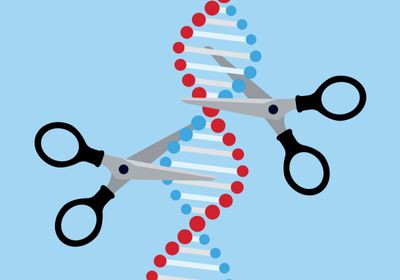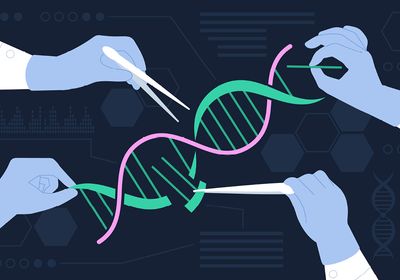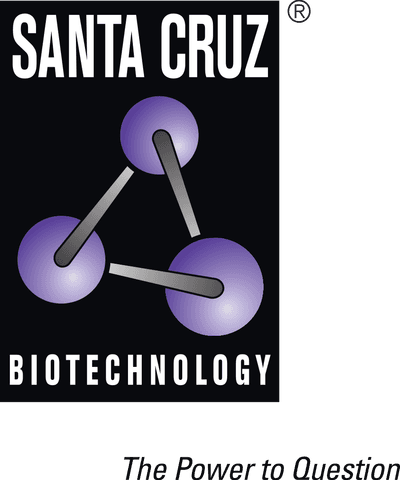ABOVE: Gene editing tools that cut one or both strands of DNA can introduce undesired mutations into the genome. © iStock, traffic_analyzer
New gene editing tools could become gamechangers for gene therapy, but scientists need to develop new approaches that curtail undesirable mutations. The clustered regularly interspaced short palindromic repeats (CRISPR)-Cas9 system is one such error-prone editing tool that scientists later modified to limit its mutational burden.1 However, it’s unclear how the adapted techniques, called base and prime editing, stack up against the original CRISPR-Cas9 system.2 Reporting in the journal Nature Biotechnology, researchers at the San Raffaele Scientific Institute revealed that base and prime editing produced more mutations than previously suggested but produced them less often than CRISPR-Cas9.3
CRISPR-Cas9 gene editing relies on a guide RNA that binds to a desired DNA sequence and a Cas9 enzyme that cuts both strands of DNA at that site, creating a double-strand break. Scientists edit the sequences at the cut ends before using different approaches to guide repair. However, there are often additional DNA sequences with blunt ends in the nucleus that could accidentally get jumbled with the cut ends during repair, leading to mutations. Therefore, researchers adapted CRISPR-Cas9 techniques to nick a base out of one strand while leaving the complementary strand intact, thereby preventing the random joining of blunt and cut ends that lead to mutations.2
Luigi Naldini, a gene therapy researcher and coauthor of the study, has run cost-benefit analyses of gene editing tools throughout his career.4,5 He said, “It was obvious to us that we [should] similarly investigate whether base editing indeed provided a benefit over the previous editing technology.” He hypothesized that when the nicked strand unzips from the intact complementary strand during replication, it could serve as a template to make a second nicked strand. This would create a DNA double helix with a blunt end that could randomly join up with another blunt end, thus rendering the DNA vulnerable to mutations.
See Also “A CRISPR Alternative for Correcting Mutations That Sensitize Cells to DNA Damage”
To find out whether base editors were truly less error-prone than CRISPR-Cas9 tools, the team compared their DNA editing performance. They chose to target the gene for β2-microglobulin because it encodes a cell-surface protein that is easy to detect and quantify with antibodies. Using both technologies, they modified the gene in hematopoietic stem cells (HSC), a common gene therapy target for blood disorders.6 Both tools deleted the gene with comparably high efficiency (approximately 80 to 90 percent), but base editors produced far fewer undesired mutations than the CRISPR-Cas9 tool. As Naldini suspected, the team detected mutations arising from double-strand breaks in base edited cells, albeit at a lower level than in the CRISPR-Cas9 edited cells. These mutations occurred at the nicked site, suggesting that it was transformed into an accidental double-strand break during replication. “It’s wrong to say that this technology is break-free,” Naldini said.
The team also explored whether the editing systems triggered undesired cellular responses. The CRISPR-Cas9 tool appeared to activate a DNA repair pathway governed by p53, a protein known as the “guardian of the genome.”7 This was expected for an editing tool that deliberately generates double-strand breaks; however, they also detected p53 activation at a reduced level for a specific base editor that converts cytosine into thymine.
CRISPR-Cas9 outperformed base editors in one regard: It didn’t trigger innate immunity. Base editors use long guide RNAs that are viewed by the cell as foreign, triggering immune responses.8
These responses cause concern because the yield of edited HSC produced for gene therapy is never 100 percent. Over time, edited cells may die if they are outnumbered by unedited ones unencumbered by stress responses, reducing the durability of the therapy. “It’s probably negative selection of those cells that experienced maybe the highest burden of detrimental responses and outcomes,” suggested Samuele Ferrari, a biotechnologist and coauthor of the study.
“Probably the main message is the safety of the novel technology,” said Annarita Miccio, a molecular biologist at the Institut Imagine who was not involved with the work. Her colleague Mégane Brusson, who also was not involved in the study, added, “It’s true that there are less genotoxic risks with base editors and prime editors, but as they show in this paper, there is still some concern that we have to take into account when we develop gene therapy or genome-editing strategies for therapeutic approaches.”
Fortunately, the researchers found a way to reduce most of the genotoxic effects of base editors to an undetectable level by first optimizing the guide RNAs and then lowering the dosage used. To prolong the lifespan of RNA, they added features like a 5-prime cap that prevent their breakdown in the cell.9 However, optimization did not completely abolish all undesired effects. Base editors still triggered mutations at random sites in the genome beyond the target site.
Lastly, the team explored prime editing, the other nicking technique. Instead of modifying a single base pair, it removes several bases out of one strand of a gene and inserts new ones in their place.2 “This is the latest kid on the block among all the editing tools,” Ferrari said, adding that owing to its infancy, “Prime editing has not been yet tested in clinical settings.”
See Also “Prime Editing Comes of Age”
Similar to base editing, prime editing led to mutations at the nick site that signified the accidental formation of double-strand breaks and triggered the p53 DNA repair pathway plus immune signaling. As with base editing, the tool will need to be optimized to avoid these unwanted cellular responses.
Base and prime editing also spawn undesired effects that can only be spotted with scrupulous screening. “As a field, we don’t know too much about data in clinical trials regarding, for example, long-range deletions,” noted Ferrari.
Brusson said, “In the future, we need more powerful technology to better characterize the genotoxic effects of base and prime editing technology.”
Miccio and her team are exploring epigenome editing as an alternative tool for modulating genes in therapy.10 These tools activate or repress genes by modifying chromatin structure, and they don’t introduce mutations in the genome. “This would theoretically be the best and safest strategy that would definitely avoid all these genotoxic effects because there is no enzyme that is modifying the DNA,” she said.
UK regulators recently approved CRISPR-Cas9 for treating sickle-cell disease and β-thalassemia, and researchers have already used base-edited cells to treat leukemia in a 13-year old girl in the UK .11 Although these editing tools have the potential to save lives, this study suggests that it may be worth further examining their genotoxic risks.
References
- Doudna JA & Charpentier E. The new frontier of genome engineering with CRISPR-Cas9. Science. 2014;346(6213):1258096.
- Kantor A, et al. CRISPR-Cas9 DNA base-editing and prime-editing. Int J Mol Sci. 2020;21(17):6240.
- Fiumara M, et al. Genotoxic effects of base and prime editing in human hematopoietic stem cells. Nat Biotechnol. 2023;s41587-023-01915-4.
- Gabriel R, et al. An unbiased genome-wide analysis of zinc-finger nuclease specificity. Nat Biotechnol. 2011;29:816-823.
- Ferrari S, et al. Efficient gene editing of human long-term hematopoietic stem cells validated by clonal tracking. Nat Biotechnol. 2020;38(4):1298-1308.
- Antoniou P, et al. Base and prime editing technologies for blood disorders. Front Genome Ed. 2021;3:61846.
- Feroz W & Sheikh AMA. Exploring the multiple roles of guardian of the genome: P53. Egypt J Med Hum Genet. 2020;21(49):s43042-020-00089-x.
- Schubert MS, et al. Chemical modification of CRISPR gRNAs eliminate type I Interferon responses in human peripheral blood mononuclear cells. J Cytokine Biol. 2018;3(21):121.
- Gerstel B, et al. The effects of 5′-capping, 3′-polyadenylation and leader composition upon the translation and stability of mRNA in a cell-free extract derived from the yeast Saccharomyces cerevisiae. Mol Microbiol. 1992;6(16):2339-2348.
- Syding LM, et al. CRISPR/Cas9 epigenome editing potential for rare imprinting diseases: A review. Cells. 2020;9(4):993.
- Chiesa R, et al. Base-edited CAR7 T cells for relapsed T-cell acute lymphoblastic leukemia. NEJM. 2023;389:899-910.







